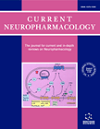- Home
- A-Z Publications
- Current Neuropharmacology
- Previous Issues
- Volume 5, Issue 4, 2007
Current Neuropharmacology - Volume 5, Issue 4, 2007
Volume 5, Issue 4, 2007
-
-
Human 5-HT4 and 5-HT7 Receptor Splice Variants: Are they Important?
More LessAuthors: Ian M. Coupar, Paul V. Desmond and Helen R. IrvingG-protein-coupled receptors (GPCRs), which are encoded by >300 genes in the human genome, are by far the largest class of targets for modern drugs. These macromolecules display inherent adaptability of function, which is partly due to the production of different forms of the receptor protein. These are commonly called ‘isoforms’ or ‘splice variants’ denoting the molecular process of their production/ assembly. Not all Read More
-
-
-
Anti-inflammatory and Immune Therapy for Alzheimer's Disease: Current Status and Future Directions
More LessAuthors: Douglas Walker and Lih-Fen LueFrom the initial characterizations of inflammatory responses in Alzheimer's disease (AD) affected brains, namely the demonstration of activated microglia and reactive astrocytes, complement system activation, increased production of proinflammatory cytokines, and evidence for microglial-produced neurotoxins, there was hope that reducing inflammation might be a feasible treatment for this memory-robbing disease. This Read More
-
-
-
The ERK 1 and 2 Pathway in the Nervous System: From Basic Aspects to Possible Clinical Applications in Pain and Visceral Dysfunction
More LessAuthors: Celia D. Cruz and Francisco CruzThe extracellular signal-regulated kinases 1 and 2 (ERK) cascade, member of the mitogen-activated protein kinases superfamily of signalling pathways, is one of the best characterized pathways as many protein interactions and phosphorylation events have been systematically studied. Traditionally, ERK are associated with the regulation of proliferation and differentiation as well as survival of various cell types. Their acti Read More
-
-
-
Pharmacology of Cell Adhesion Molecules of the Nervous System
More LessAuthors: Darya Kiryushko, Elisabeth Bock and Vladimir BerezinCell adhesion molecules (CAMs) play a pivotal role in the development and maintenance of the nervous system under normal conditions. They also are involved in numerous pathological processes such as inflammation, degenerative disorders, and cancer, making them attractive targets for drug development. The majority of CAMs are signal transducing receptors. CAM-induced intracellular signalling is triggered via homophili Read More
-
-
-
Endocannabinoid Signaling in Midbrain Dopamine Neurons: More than Physiology?
More LessDifferent classes of neurons in the CNS utilize endogenous cannabinoids as retrograde messengers to shape afferent activity in a short- and long-lasting fashion. Transient suppression of excitation and inhibition as well as long-term depression or potentiation in many brain regions require endocannabinoids to be released by the postsynaptic neurons and activate presynaptic CB1 receptors. Memory consolidation and/or exti Read More
-
-
-
Emerging Synergisms Between Drugs and Physiologically-Patterned Weak Magnetic Fields: Implications for Neuropharmacology and the Human Population in the Twenty-First Century
More LessAuthors: P. D. Whissell and M. A. PersingerSynergisms between pharmacological agents and endogenous neurotransmitters are familiar and frequent. The present review describes the experimental evidence for interactions between neuropharmacological compounds and the classes of weak magnetic fields that might be encountered in our daily environments. Whereas drugs mediate their effects through specific spatial (molecular) structures, magnetic fi Read More
-
-
-
The Neuropharmacology of (-)-Stepholidine and its Potential Applications
More LessAuthors: Kechun Yang, Guozhang Jin and Jie Wu(-)-Stepholidine (SPD), a natural product isolated from the Chinese herb Stephania, possesses dopamine (DA) D1 partial agonistic and D2 antagonistic properties in the nigrostriatal and mesocorticolimbic DAergic pathways. These unique dual effects have suggested that SPD can effectively restore previously imbalanced functional linkage between D1 and D2 receptors under schizophrenic conditions, in which, SPD Read More
-
Volumes & issues
-
Volume 23 (2025)
-
Volume 22 (2024)
-
Volume 21 (2023)
-
Volume 20 (2022)
-
Volume 19 (2021)
-
Volume 18 (2020)
-
Volume 17 (2019)
-
Volume 16 (2018)
-
Volume 15 (2017)
-
Volume 14 (2016)
-
Volume 13 (2015)
-
Volume 12 (2014)
-
Volume 11 (2013)
-
Volume 10 (2012)
-
Volume 9 (2011)
-
Volume 8 (2010)
-
Volume 7 (2009)
-
Volume 6 (2008)
-
Volume 5 (2007)
-
Volume 4 (2006)
-
Volume 3 (2005)
-
Volume 2 (2004)
-
Volume 1 (2003)
Most Read This Month
Article
content/journals/cn
Journal
10
5
false
en


